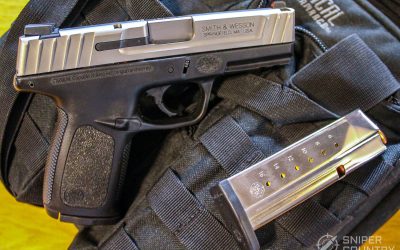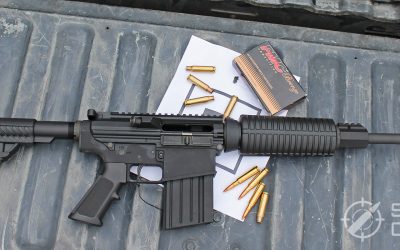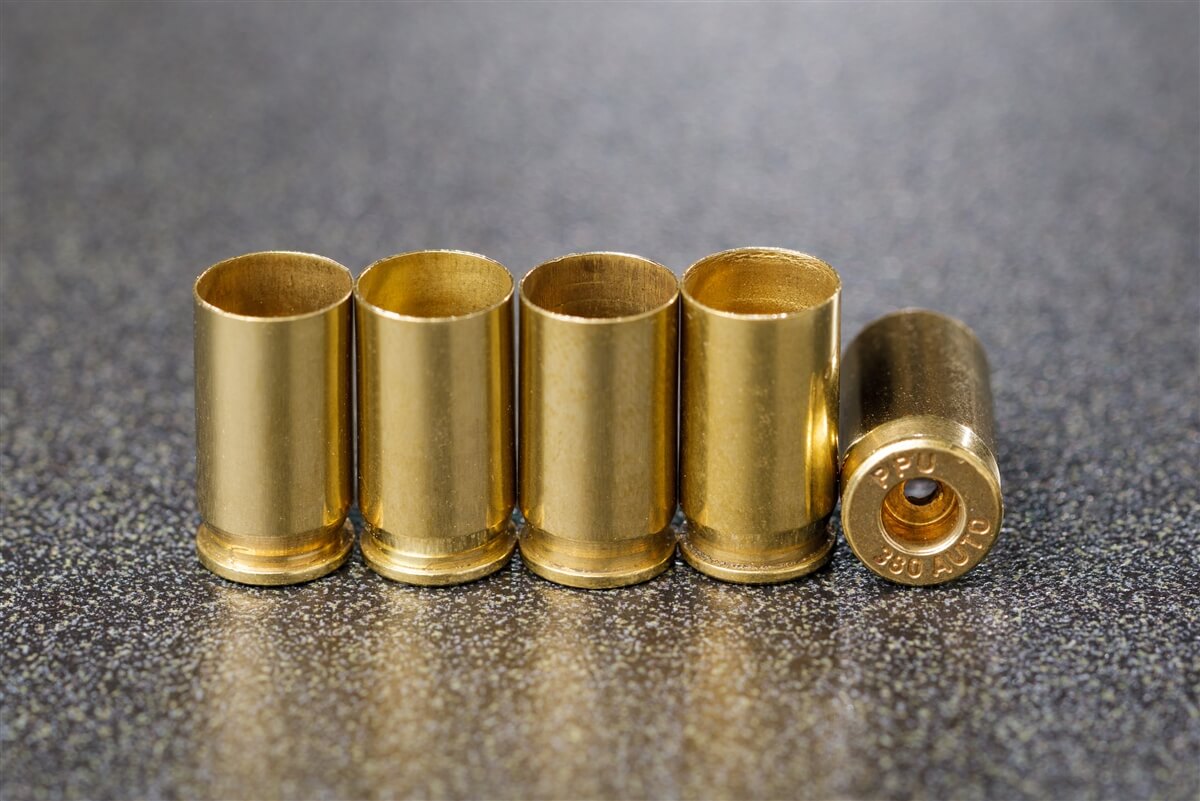You need a new barrel, maybe this is a new build or maybe your old barrel just isn’t cutting it anymore. But you don’t just want new, you want the best AR-15 barrel you can find (and afford).
Lucky for you, we got all that a whole lot more.
If you want a crash course in all things barrels, I’ve got some reading for you — or if you just want the quick answer to what we recommend, we have that too!
Options To Consider When Buying
Imma about to hit you with a whole lot of information, it’s useful I promise, but if you just want to… buy a barrel, you can skip it.
If you want to know why you should buy A instead of B, you will love this info.
It’s an education, but worth it.
BONUS OFFER: Get your free shooting range targets to print at home!
Get your free targets to print at home!
5.56 NATO, .223 Remington, and .223 Wylde
It might surprise you to find out that all three of these calibers are basically the same thing. Actually, calling them each caliber is a bit wrong.
5.56 NATO is a cartridge and chamber, so is .223 Remington — their cartridges are fundamentally made to slightly different standards.
.223 Wylde is only a chamber spec for barrels, there is no corresponding cartridge for it.
.223 Remington was what Stoner, Armalite, Colt, and Remington first designed for the AR-15 and the M16. It’s a high velocity, flat-shooting, speedy cartridge.
But during testing the military decided they needed the spec for the cartridge to be slightly different, they wanted the chamber pressure reduced slightly so that they could have a larger margin for error in ammo quality and so they could more safely use things like tracers.
This was done by making the chamber spec slightly larger.
The resulting final spec was 5.56 NATO, a technically high possible pressure spec.
Because of this, it is generally advised that while .223 Rem is totally safe to shoot in 5.56 NATO barrels, 5.56 NATO should not be fired in .223 Rem barrels.
This is… mostly true, it’s not recommended. But I’ve never, ever heard of someone having an issue.
On the other hand, finding a true .223 Remington AR-15 barrel is extremely rare these days, nearly all of them are 5.56 NATO.
.223 Wylde came later and is basically a compromise between the two chamber specs. Wylde’s dimensions are slightly tighter than 5.56 NATO’s but not as tight as .223 Remington.
The result is the ability to shoot both .223 Rem and 5.56 NATO safely, but with more accuracy than 5.56 NATO.
I strongly recommend .223 Wylde if you have the option, it is a better chamber and will produce better accuracy. However, I wouldn’t call it critical.
Need ammo? Take a look at the Best 5.56 NATO Ammo!
BONUS OFFER: Get your free shooting range targets to print at home!
Get your free targets to print at home!
Cold Hammer Forged Vs. Not
Cold Hammer Forging is a method of manufacturing a barrel. The equipment to set up CHF is very, very expensive but producing each barrel is significantly lower — but because that start-up cost is so high, not many manufacturers offer CHF barrels.
The ones that do charge more for them. Why? Technically speaking CHF results in a better barrel.
“Better” means it is more durable and you will probably get more life out of it.
It’s important to note that CHF barrels are not inherently more accurate, they don’t produce higher muzzle velocity, they aren’t easier to clean, what they are is more durable — period.
While a standard barrel might get 10,000 rounds of 5.56 NATO before losing accuracy, a CHF barrel might get 15,000 or 20,000 or 11,000. It’s kind of a mystery.
The deep technical answers to these questions would require way too many words for this article, but the bottom line is that while CHF barrels are better, how much better massively depends on your style of shooting.
It is entirely possible for a CHF barrel to be burnt out before a standard barrel if the CHF barrel is abused harder.
Given totally equal circumstances though, CHF will last longer… I have no idea how much longer though.
I’ve never seen a reputable test that had a data sample high enough to call reliable.
All of this begs the question: Do you need a CHF barrel?
The more abusive to your barrel you plan on being, the more helpful CHF is. If you’re building a 24″ slow-fire plinking rifle, CHF is almost meaningless.
If you’re building a 11.5″ SBR with a suppressor and the gas wide open because you plan on shooting a steel case with a forced reset trigger and 60-round mags and live on a houseboat, CHF is basically required.
For me, CHF isn’t something I really go out of my way to get. If the barrel I want is CHF, then that’s awesome. But if it isn’t, that’s okay. If I have the option between two barrels and one is CHF and the other isn’t, as long as the CHF option isn’t 2x the price — I’ll get the CHF.
Cold hammer-forged barrels are better, this is a fact. But a normal barrel won’t fall apart either. That said, if you want the most durable and best AR-15 barrel you can get — CHF is a must.
Popular Articles
Chrome Lining
Much like CHF, chrome lining increases durability — but how much is highly questionable.
Back in the old days, chrome lining was a method to make your barrel last longer and be more resistant to things like saltwater but it also resulted in a loss of accuracy. How big a loss depended on random luck more than anything.
Since then manufacturers have gotten a lot better at chrome lining barrels and the accuracy problem is mostly a non-factor now.
Chrome-lined barrels can still have less accuracy potential than non-lined barrels, but for the average shooter, it isn’t enough to matter.
And much like CHF, chrome-lined barrels are normally more expensive.
I approach chrome lining the same way I do CHF, it’s nice but I don’t go out of my way.
However, unlike CHF, chrome-lined barrels do have a real major difference in one way — their ability to survive water and saltwater.
If you live near the sea, own a boat, or are in places that get a lot of rain then a chrome-lined barrel will go a long way to prevent rust in your bore.
For me, I live in the Southern California desert so chrome lining is kind of a waste. But my brother who lives north of Seattle gets a lot of use out of chrome lining.
Fluting
I have to admit that I’m biased against fluting. I think a lot of companies try to use it as a selling point because it looks cool so they talk up the “benefits” of fluting to sucker people into buying it.
Fluting is the act of cutting a pattern into the outside of the barrel. Sometimes it’s flames, sometimes just straight ridges, there are lots of ways of doing it.
This removes material and makes the barrel lighter — it also increases surface area so that the barrel will cool down faster.
However, since it removed material it also means the barrel won’t be able to absorb as much heat before getting very hot. As a barrel heats up, it loses accuracy.
The major problem that can occur with fluting is that most brands that offer it don’t do it correctly and the services that offer it as an aftermarket option almost never do it correctly.
Fluting creates new stresses in the barrel, when the barrel gets hot this can harm accuracy or even shift your point of impact dramatically.
Even when a barrel has been fluted and correctly stress relived afterward, the barrel can still lose more accuracy when heated than if it hadn’t been fluted.
While fluting looks cool, and I have some 10/22 barrels that are fluted for just that reason, it doesn’t give you a practical advantage — except in a limited area.
Fluting drops the weight but decreases the number of accurate shots you can take in a given amount of time.
If your application doesn’t require high precision or doesn’t require more than a few shots in a row, then the downsides of fluting aren’t a big deal.
I strongly discourage aftermarket fluting due to how difficult it is to properly stress relief the barrel. You can take the best AR-15 barrel ever made and ruin it with improper fluting.
Length
Legally speaking the minimum barrel length for a rifle in the USA is 16″. If you’re building a pistol or SBR, there is no limit.
More length gives you greater muzzle velocity and more possible room on your handguard for things like lights, your hand placement, etc.
However, length increases weight and makes it harder to move around within closed environments like your home.
There are some exceptions to this, but generally speaking, I recommend a few lengths:
- 16-inches: Do all rifle, home defense, field use, SHTF, etc.
- 14.5-inches with a pinned and welded muzzle device: Home defense.
- 11.5-inches: Pistol and SBR only — home defense, SHTF, close-range applications.
- 20-inches: Clone builds, hunting, long range shooting.
- 24-inches+: Hunting and long range shooting, these barrels are harder to find and require special gas systems.
Profile
This is the general shape that the barrel comes in. The most common profile is “government” where it starts out thickish, tapers down to the gas block, gets much thicker for a while, and then back down.
While this is by far the most common profile, it sucks. Honestly, it’s hard to understand why this profile has existed for so long.
Even when it was designed, it was a mistake. Literally. It’s a crazy story and for the whole thing, take a look at this post from EveryDayMarksman.
TL;DR — the Marines thought they were bending barrels during bayonet training in the 1980s, so they redesigned the barrel to have a thicker front end. Turns out, that wasn’t the cause of their “bent” barrels. But by then it was too late to change so… oh well, we have weird-shaped barrels now.
Basically what I’m trying to say is that if you want to save money, a government profile is normally cheaper and “fine.”
But there is a whole world of barrel shapes out there and I recommend those instead.
Pencil profiles are about as thin as you can get, these are lightweight but heat up fast causing your groups to get bigger. For home defense, training, or plinking — these are awesome.
Gunner profile is basically a slightly thicker pencil, great for attaching a suppressor to or soaking a little more heat. This is my preferred style and hands down one of the best AR-15 barrel types.
Bull barrels are huge, thick barrels that start thick and stay thick. These are great for long-range precision shooting but are heavy.
Sporter barrels are kind of like pencil or gunner, but slightly different shapes. Great as a balance between heat and weight while leaning on the lightweight side.
Some brands have a proprietary name for these things like Ballistic Advantage’s “Hanson” profile. A lot of the time you’ll just need to look closely at the specs to tell what profile these really are.
Twist Rate
This is how much twist is imparted to the bullet while in the barrel, shocking I know. You’ll see it written as 1:8 or 1-8 or 1/8, it all means the same thing — 1 full revolution per 8 inches of barrel.
Most commonly for 5.56 NATO are rates of 1:7, 1:8, and 1:9, although rarely you’ll still see 1:12 also.
Technically speaking, the twist you need depends on the length of the bullet. But that is kind of annoying to measure. Weight is not perfectly 1:1 with length, but it is close enough that it’s the standard we use.
The lighter the bullet the slower your twist. Heavy bullets need a lot of twist. 1:12 is good for 55gr, but horrible for anything above 62gr. 1:6 twist (another rare one to see) is good for super heavy 70-80gr, but not good at all for lighter 55gr.
1:7 twist is mil-spec, it does well at slightly heavyweights like 62gr-77gr.
However, you’re not limited to mil-spec — you can do better than that. You can choose from the best AR-15 barrels. Unless you have an odd niche use for your rifle, I recommend the 1:8 twist for basically everyone.
1:8 is great for everything from 55gr to 77gr and this basically covers everything you’ll want to shoot.
Technically speaking, it’s weakest for the lighter stuff — but the lighter bullets like 55gr are also really not designed for precision shooting. Thus, the less ideal stabilization won’t matter much.
Nice, right.
Carbon Fiber Vs. Steel
Another product I have a bone to pick with, carbon fiber-wrapped barrels. I’m not sure why anyone would consider these some of the best AR-15 barrels.
Kind of like with fluting, CF-wrapped barrels are a bit of a smoke, and mirrors show. There is a lot of science to unpack with this one and thermodynamics is complex — so we’ll save that for some other time.
The bottom line though, CF barrels don’t work as well as most CF barrel brands claim they do.
Much like fluting, they reduce weight but also reduce how much heat they can handle.
And again like fluting, the CF introduces issues with how the barrel flexes when it heats up and especially as it cools.
This is the part that is very complex but it comes down to a number of issues such as the resin used, the resin being uneven, the resin not heating/cooling at the same rate as the CF, the CF not heating/cooling evenly, and the underlying steel also heating/cooling at different rates.
It’s a lot of moving parts in a system that shouldn’t move.
It also just doesn’t help reduce as much weight as you might think.
A Proof Research Carbon Fiber wrapped barrel in .223 Wylde and 16″ long is 1 pound 12 ounces. But a Faxon 16″ .223 Wylde Gunner profile barrel is 1 pound 5 ounces. Lighter than the CF barrel.
This is another reason to pay attention to what profile of barrel you’re buying.
BONUS OFFER: Get your free shooting range targets to print at home!
Get your free targets to print at home!
Best AR-15 Barrels
Faxon Firearms
One of my go-to brands when I need a barrel, Faxon Firearms was one of the first to really unlock the secrets of making a thin barrel correctly.
And they still make some of the best AR-15 barrels.
I have two home defense ARs, one has a Faxon pencil barrel and the other has a Faxon gunner profile.
Both are outstanding, accurate, and very lightweight.
Their normal barrels are great, but their match barrels are awesome. I run one of the heavy match 6mm ARC barrels in my precision rifle and print some amazing groups with it.
And on top of it all, their price isn’t too bad either.
Take a look at their AR barrels, their pistol barrels, and the 10/22 barrels.
Ballistic Advantage
Another brand that offers a lightweight barrel that is actually good, BA’s Hanson profile is about as light as Faxon’s gunner profile and is every inch as good.
Aero Precision owns Ballistic Advantage and sources their barrels from them, so they are kind of the same company.
Both are well known for quality at a good price. Not the cheapest, but definitely one of the best values and bangs for your buck.
I’ve never been disappointed with a BA barrel and I know you won’t be either.
Criterion Barrels
If you want a go-to-war quality barrel that can also hold its own at a match, Criterion is for you.
I’ve owned two personally, an AR-10 barrel in 6.5 Creedmoor and an AR-15 barrel in 6.5 Grendel — both were sub-MOA. Both were built like tanks.
What really sells them for me is their staff are some of the most knowledgeable barrel experts in the world.
I stopped by their SHOT booth in 2020 and got distracted listening to the owner discussing a very deep dive and technical conversation with a world champion bench rest shooter from the EU.
I learned more in 20 minutes of eavesdropping than I have in a whole year of research.
Criterion specializes in making ultra-durable barrels that are also far more accurate than the average combat rifle should be.
If you need the best of both worlds, I highly recommend them.
Rainier Arms
You might not have expected a retailer from Seattle to have an awesome line of in-house barrels, but Rainier Arms does.
They aren’t the best match barrels I’ve ever shot, but for the price, they were outstanding and normally sub-MOA.
The price makes them very attractive though when they are in stock they come in far under what a normal match barrel costs and deliver a lot per dollar.
They also come in longer than normal lengths so getting a 20 or 24 inches is fairly easy — when they are in stock.
Daniel Defense
A huge name in the barrel and AR world, Daniel Defense is a classic that never dies.
CHF and chrome-lined, DD barrels are literally barrels you can take to a warzone.
If you’re building an SHTF barrel, this should be one of the top of your list to consider.
Daniel Defense also goes the extra step of pinning their gas blocks and rock setting their muzzle devices.
This makes things harder to change out if you wanted to but is the most secure and durable way of doing things. If you want the best AR-15 barrel you can find, this is one of them.
Wrapping Up
There are a lot of great AR-15 barrels on the market, so this should give you a great start.
For an every-day-do-all barrel, I love Faxon’s gunner profile.
If you need the most durable option possible, Daniel Defense is my pick.
For a match rifle or a rifle you want to be able to abuse in the field while still getting a lot of precision from, Criterion has you covered.










![9mm Glock Models [Ultimate Guide]](https://snipercountry.com/wp-content/uploads/2018/10/Glock-17-vs-Glock-19-vs-Glock-26-vs-Glock-41-vs-Glock-43-WM-400x250.jpg)
![Handgun Caliber Chart [2025 Ultimate Guide]](https://snipercountry.com/wp-content/uploads/2018/10/Handgun-Caliber-Comparison-400x250.jpg)
![Rifle Calibers [Ultimate Guide]](https://snipercountry.com/wp-content/uploads/2018/12/Header-1900-400x250.jpg)








2 Responses
Great and easy read with useful information.
Thanks for this well written article! I want to move into longer range precision shooting with my next build but was unsure what characteristics to consider when selecting the barrel. The information provided is a great education for me.